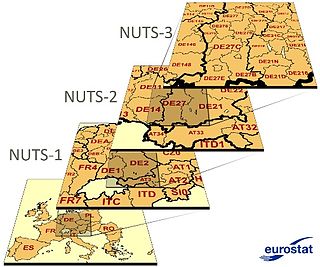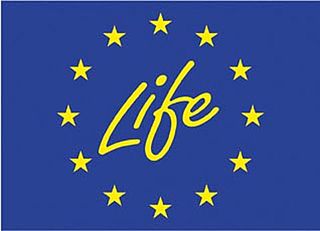
The European Union (EU) is a supranational political and economic union of 27 member states that are located primarily in Europe. The union has a total area of 4,233,255 km2 (1,634,469 sq mi) and an estimated total population of over 448 million. The EU has often been described as a sui generis political entity combining the characteristics of both a federation and a confederation.

Nomenclature of Territorial Units for Statistics or NUTS is a geocode standard for referencing the administrative divisions of countries for statistical purposes. The standard, adopted in 2003, is developed and regulated by the European Union, and thus only covers the EU member states in detail. The Nomenclature of Territorial Units for Statistics is instrumental in the European Union's Structural Funds and Cohesion Fund delivery mechanisms and for locating the area where goods and services subject to European public procurement legislation are to be delivered.

A European political party, known formally as a political party at European level and informally as a Europarty, is a type of political party organisation operating transnationally in Europe and within the institutions of the European Union (EU). They are regulated and funded by EU Regulation No. 1141/2014 on European Political Parties and European Political Foundations and their operations are supervised by the EU Authority for European Political Parties and European Political Foundations. European political parties – usually made up of national parties, not individuals – have the exclusive right to campaign during the European elections and express themselves within the European Parliament by their affiliated political groups and their MEPs. Europarties influence the decision-making process of the European Council through coordination meetings with their affiliated heads of state and government. They also work closely and co-ordinate with their affiliated members of the European Commission.

European Union citizenship is afforded to all citizens of member states of the European Union (EU). It was formally created with the adoption of the 1992 Maastricht Treaty, at the same time as the creation of the EU. EU citizenship is additional to, as it does not replace, national citizenship. It affords EU citizens with rights, freedoms and legal protections available under EU law.
The European Institute of Innovation and Technology (EIT) is an independent body of the European Union with juridical personality, established in 2008 intended to strengthen Europe's ability to innovate. The EIT’s three “core pillars” of activities are: entrepreneurial education programmes and courses across Europe that transform students into entrepreneurs; business creation and acceleration services that scale ideas and budding businesses; and innovation-driven research projects that turn ideas into products by connecting partners, investors, and expertise.

The energy policy of the European Union focuses on energy security, sustainability, and integrating the energy markets of member states. An increasingly important part of it is climate policy. A key energy policy adopted in 2009 is the 20/20/20 objectives, binding for all EU Member States. The target involved increasing the share of renewable energy in its final energy use to 20%, reduce greenhouse gases by 20% and increase energy efficiency by 20%. After this target was met, new targets for 2030 were set at a 55% reduction of greenhouse gas emissions by 2030 as part of the European Green Deal. After the Russian invasion of Ukraine, the EU's energy policy turned more towards energy security in their REPowerEU policy package, which boosts both renewable deployment and fossil fuel infrastructure for alternative suppliers.
Asylum shopping is a term for the practice by some asylum seekers of applying for asylum in several states or seeking to apply in a particular state after traveling through other states. It is used mostly in the context of the European Union and the Schengen Area, but has also been used by the Federal Court of Canada.

A Norwegian passport is the passport issued to nationals of Norway for the purpose of international travel. Beside serving as proof of Norwegian citizenship, they facilitate the process of securing assistance from Norwegian consular officials abroad.

The European Union itself does not issue ordinary passports, but ordinary passport booklets issued by its 27 member states share a common format. This common format features a coloured cover emblazoned—in the official language(s) of the issuing country —with the title "European Union", followed by the name(s) of the member state, the heraldic "Arms" of the State concerned, the word "PASSPORT", together with the biometric passport symbol at the bottom centre of the front cover.

The Treaty on the Functioning of the European Union (TFEU) is one of two treaties forming the constitutional basis of the European Union (EU), the other being the Treaty on European Union (TEU). It was previously known as the Treaty Establishing the European Community (TEC).

The Schengen Area is an area comprising 27 European countries that have officially abolished many passport and many other types of border control at their mutual borders. Being an element within the wider area of freedom, security and justice policy of the European Union (EU), it mostly functions as a single jurisdiction under a common visa policy for international travel purposes. The area is named after the 1985 Schengen Agreement and the 1990 Schengen Convention, both signed in Schengen, Luxembourg.
The Unit of Rehabilitation of Victims of Torture (URVT) has operated in Cyprus since 2005.

The LIFE programme is the European Union's funding instrument for the environment and climate action. The general objective of LIFE is to contribute to the implementation, updating and development of EU environmental and climate policy and legislation by co-financing projects with European added value. LIFE began in 1992 and to date there have been five phases of the programme. During this period, LIFE has co-financed some 4600 projects across the EU, with a total contribution of approximately 6.5 billion Euros to the protection of the environment and of climate. For the next phase of the programme (2021–2027) the European Commission proposed to raise the budget to 5.45 billion Euro.

The area of freedom, security and justice (AFSJ) of the European Union (EU) is a policy domain concerning home affairs and migration, justice as well as fundamental rights, developed to address the challenges posed to internal security by collateral effects of the free movement of people and goods in the absence of border controls or customs inspection throughout the Schengen Area, as well as to safeguard adherence to the common European values through ensuring that the fundamental rights of people are respected across the EU.

The European Union Agency for Asylum (EUAA) is an agency created by European Union Regulation 439/2010 within the area of freedom, security and justice framework to increase the cooperation of EU member states on asylum, improve the implementation of the Common European Asylum System, and support member states under pressure.
The European Refugee Fund (ERF) was a scheme designed to facilitate the sharing of the financial costs of the reception, integration and voluntary repatriation of refugees amongst European Union member states. All EU member states apart from Denmark participated in the ERF. The Fund financed both national and transnational projects, including providing skills and language training to refugees, improvements to reception facilities and refugee resettlement or relocation operations. The ERF was allocated €630 million in funding over the period 2008–13. It was set up in 2000, replacing previous ad hoc funding measures. In April 2014, the ERF, along with the European Integration Fund and the European Return Fund, was replaced by the Asylum Migration and Integration Fund (AMIF) established for the period 2014–20.
The migration and asylum policy of the European Union is within the area of freedom, security and justice, established to develop and harmonise principles and measures used by member countries of the European Union to regulate migration processes and to manage issues concerning asylum and refugee status in the European Union, in particular in the Schengen Area.

The Temporary Protection Directive is a 2001 European Union directive providing for immediate, temporary protection for displaced people from outside the external border of the Union, intended to be used in exceptional circumstances when the regular EU asylum system has trouble handling a "mass influx" of refugees. It was introduced in the aftermath of the Yugoslav Wars, but was not used before 2022. When invoked, it requires EU member states to accept refugees as allocated based on their capacity to host them, following a principle of solidarity and a "balance of efforts" among member states.

The Ministry of Migration and Asylum is the official government body that oversees migration and asylum policy issues in Greece. It also contributes and implements European policies on Migration. It collaborates with the European Union Agency for Asylum, the International Organization for Migration and the United Nations. It receives funding from the Asylum, Migration and Integration Fund, the Internal Security Fund and the European Recovery and Resilience Fund. The Ministry of Migration and Asylum was established in January 15, 2020. The Ministry of Migration Policy, established in 2016, was abolished on July 8, 2019.













